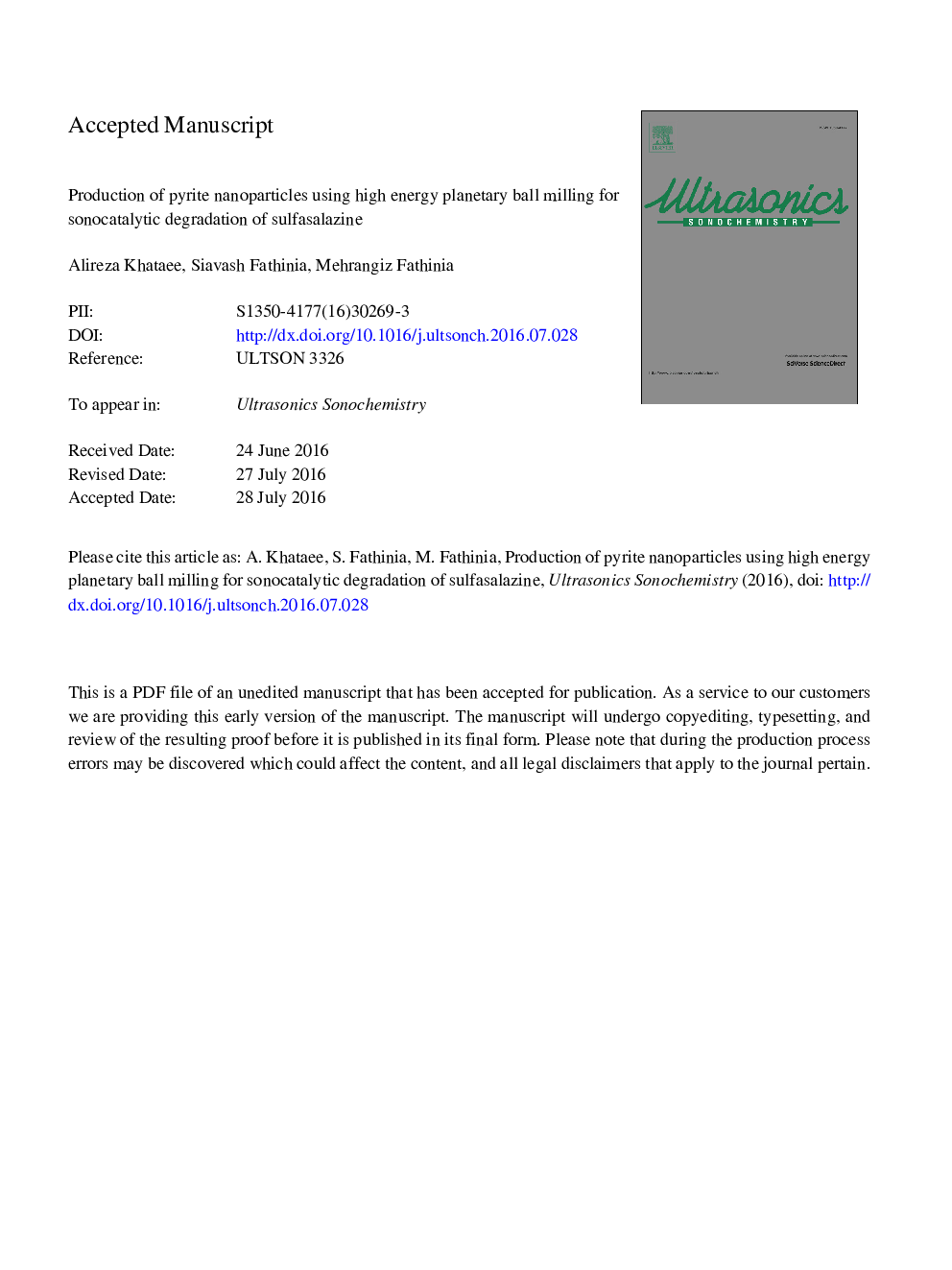| کد مقاله | کد نشریه | سال انتشار | مقاله انگلیسی | نسخه تمام متن |
|---|---|---|---|---|
| 7703745 | 1496870 | 2017 | 58 صفحه PDF | دانلود رایگان |
عنوان انگلیسی مقاله ISI
Production of pyrite nanoparticles using high energy planetary ball milling for sonocatalytic degradation of sulfasalazine
ترجمه فارسی عنوان
تولید نانوذرات پرییت با استفاده از میلز سیاره ای با انرژی بالا برای تخریب سونوکاتالیتی سولفاسالازین
دانلود مقاله + سفارش ترجمه
دانلود مقاله ISI انگلیسی
رایگان برای ایرانیان
کلمات کلیدی
آسیاب توپ سیاره ای، نانوذرات پریت، سونوکاتالیز، لانگمیرا هینشلوود، سولفاسالازین،
موضوعات مرتبط
مهندسی و علوم پایه
شیمی
شیمی (عمومی)
چکیده انگلیسی
Sonocatalytic performance of pyrite nanoparticles was evaluated by the degradation of sulfasalazine (SSZ). Pyrite nanoparticles were produced via a high energy mechanical ball milling (MBM) in different processing time from 2Â h to 6Â h, in the constant milling speed of 320Â rpm. X-ray diffraction (XRD), scanning electron microscopy (SEM) coupled with energy dispersive X-ray (EDX), Fourier transform infrared spectroscopy (FT-IR) analysis and Brunauer-Emmett-Teller (BET) confirmed the production of pyrite nanoparticles during 6Â h of ball milling with the average size distribution of 20-80Â nm. The effects of various operational parameters including pH value, catalyst amount (mg/L), SSZ concentration (mg/L), ultrasonic frequency (kHz) and reaction time on the SSZ removal efficiency were examined. The obtained results showed that the maximum removal efficiency of 97.00% was obtained at pH value of 4, catalyst dosage of 0.5Â g/L, SSZ concentration of 10Â mg/L and reaction time of 30Â min. Experimental results demonstrated that the kinetic of the degradation process can be demonstrated using Langmuir-Hinshelwood (L-H) kinetic model. The effect of different inorganic ions such as Clâ, CO32â and SO42â was investigated on the L-H reaction rate (kr) and adsorption (Ks) constants. Results showed that the presence of the mentioned ions significantly influenced the L-H constants. The impact of ethanol as a OH radical scavenger and some enhancers including H2O2 and K2S2O8 was investigated on the SSZ removal efficiency. Accordingly, the presence of ethanol suppressed SSZ degradation due to the quenching of OH radicals and the addition of K2S2O8 and H2O2 increased the SSZ removal efficiency, due to the formation of SO4â and additional OH radicals, respectively. Under the identical conditions of operating parameters, pyrite nanoparticles maintained their catalytic activity during four consecutive runs.
ناشر
Database: Elsevier - ScienceDirect (ساینس دایرکت)
Journal: Ultrasonics Sonochemistry - Volume 34, January 2017, Pages 904-915
Journal: Ultrasonics Sonochemistry - Volume 34, January 2017, Pages 904-915
نویسندگان
Alireza Khataee, Siavash Fathinia, Mehrangiz Fathinia,
